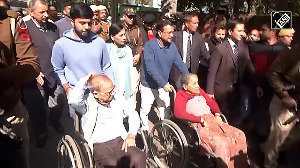The makeshift site office is abuzz with activity. Cranes and trucks criss-cross the barren land, cutting deep furrows as they go.
Labourers are hard at work on the skeleton of a sprawling, low-rise building that will soon be turning out thousands of LG Electronics colour televisions and refrigerators.
The construction site sprawls over 50 acres in Ranjangaon, a tranquil town 65 km from Pune. When completed in about four months time it will be LG's second state-of-the-art plant in India. Also, in the next few months, almost a dozen LG vendors will set up shop nearby.
It's a slightly different scene at Swarovski India's pearl coating factory about a kilometre away. Here, the walls and floors look as if they've been scrubbed to perfection and even the plants are looking specially manicured.
The plant has been dressed up to look its best because Helmut Swarovski the company founder is expected shortly at the plant.
What is it about Ranjangaon that has made it a favourite destination for multinational manufacturing companies? Ranjangaon (pop. 230,000) is a harsh, drought-prone area in the rain shadow region of the Sahayadris.
Five years ago, Business Standard visited the already-thriving town. Now, however, it has attracted a range of industries from auto manufacturer Fiat to white goods giants like Whirlpool, Matsushita and LG.
There have been occasional blips when it seemed that Ranjangaon's charms for industrial ventures, were fading. For two years investment slowed to a crawl. But now it is cranking up once again and giant plots of land are being turned into bustling construction sites.
The result is that, after a two-year lull, Ranjangaon has re-emerged as the industrial centre with the largest foreign direct investment for greenfield projects in the country.
How much investment has come to Ranjangaon? A staggering Rs 6,535 crore (Rs 65.35 billion) in the last three years (that includes money raised in GDRs).
"It is our most attractive destination," says Vidyadhar Kanade, the chief executive officer of Maharashtra Industrial Development Corporation, the state investment agency.
The companies which have planted their flag in Ranjangaon read like a Who's Who of global industry. Last year alone, companies like LG Electronics, Dow Corning and Michelin and engineering company Baekert were allotted land in Ranjangaon. Two years ago, Pepsi's Frito Lay opened shop here.
There have been ups and downs along the way. Fiat was one of the first companies to zero in on Ranjangaon back in the early '90s.
Today it sits on the largest plot in the area 250 acres but there is little else apart from a plant shell. This was scheduled to be the car maker's first greenfield project in the country.
But with its plans skidding, it continues to make its Palio cars from Kurla, at its former joint venture partner Premier Automobile's plant.
One building has been converted to a training centre but there are hardly any signs of activity. Now there is talk of Fiat starting manufacturing operations in Ranjangaon.
Close by is the blue and white plant which once belonged to another company with grand ambitions Daewoo Electronics. With the Daewoo chaebol crumbling back home, the plant was bought by its joint venture partner Anchor Electronics last month.
Now, Hemang Shah, the Anchor Electronics director wants to make the most of the boom in white goods. "We will invest Rs 100 crore (Rs 1 billion) over the next two years for capacity expansion," he says.
It wants to straddle the entire gamut with refrigerators, television, washing machines, air conditioners and microwaves.
Despite minor setbacks Ranjangaon has thrived in recent years. MIDC has carved out 704 industrial plots in the district's industrial park and so far 266 plots over 390 hectares have been allotted.
Of this, 35 units have gone into production, 17 are under construction and many others should be in action in the near future.
What's amazing is that Ranjangaon has outstripped other locations with powerful political backers. Neighbouring Baramati has been promoted tirelessly by Nationalist Congress Party leader Sharad Pawar.
Buti Bori another location singled out for industrial development, is backed by political leader Datta Meghe. And Mahad, another area identified, is a Shiv Sena stronghold.
Anil Kawade, regional officer MIDC in Pune, reckons that Ranjangaon offers a combination of factors which most other locations cannot match. Says Kawade: "It is the foreign type infrastructure that we offer that draws people to Ranjangaon."
Adds R R Mahajan, MIDC deputy engineer at Ranjangaon, "Unlike many other locations which are uneven, we have provided wide levelled roads, a water effluent plant and communication facilities."
A big plus is Ranjangaon's proximity to Pune which is a 90-minute drive away. "With sales tax incentives long gone, getting investments in the hinterland are not all that easy," says Kawade. So even as land may be cheaper in other places, the easy reach of both Mumbai and Pune adds to Ranjangaon's attractiveness.
In fact, infrastructure brought Swarovski here. "It is well organised. At that time, the state government did promise us a lot of things," says Werner Kloner, managing director of this 100 per cent export-oriented company.
According to Urmila Deshpande, manager human resources, when Swarowski decided to diversify into imitation jewellery globally, Thailand was identified as the venue.
"But being a labour intensive business, we decided that India was more cost effective," she says. It currently employees 400 people.
Since Swarovski already had a marketing office in Delhi, it looked at putting up a plant in Jaipur. But the lack of infrastructure forced it to consider other states like Chennai and Maharashtra.
And while it toyed with the idea of another site in Chakan, the easy accessibility to Pune from Ranjangaon clinched the deal.
So far, Swarovski has invested Rs 13 crore (Rs 130 million) in the business and plans to invest another Rs 25 crore (Rs 250 million) over the next three years. Last year, it exported 120 million imitation pearls.
Even LG Electronics first looked at the south and Gujarat for its second plant before settling on Ranjangaon.
"The state government offered a single window clearance and helped evaluate our business decisions," says Sachin Saxena, LG's factory head. He claims that LG is investing Rs 500 crore (Rs 5 billion) to begin with.
But it isn't that Ranjangaon has had no problems. The economic scenario did take its toll on the place. In 1997, when it was identified for development as a major industrial hub, land was available at Rs 600 per square metre.
That was the going rate for most of the prime properties across the state. Two years ago, with only 75 per cent of the land sold and the country reeling under a recession, the market-savvy state officials decided to slash land prices.
Today, the going rate is Rs 450 per square metre, even as places like Talegaon still command Rs 600. "The decision was mainly taken to attract more industries," says Kanade.
The move has worked to some extent. At the rate it is going Ranjangaon may soon be one of the top locations in the country for the manufacture of white goods.
By the year end, LG, Whirlpool, Matsushita, and Daewoo/Anchor will have together pumped in more than Rs 2,000 crore (Rs 20 billion). And there's talk of Samsung also making its way there.
But the bureaucrats have even greater ambitions. They want Ranjangaon to be a hub for auto companies as well and are actively wooing the world's top manufacturers.
Czech auto maker Skoda did, in fact, study the possibility of setting up shop in Ranjangaon before finally settling on Aurangabad. Others like Volkswagen and Hyundai have also made inquiries in the recent past.
Besides that, there's talk about other giants like the Nusli Wadia group flagship, the Rs 931.49 crore (Rs 9.314 billion) Bombay Dyeing, moving here.
MIDC officials say the textile major is looking at both Ranjangaon and Talegaon before it makes a final decision to relocate its operations from Mumbai.
MIDC is also looking at different ways to make its incentives policy for the region as attractive as possible.
When it began, tax breaks were not applicable to ancillary units of companies stationed outside the industrial park. It bent the rules for Fiat and said that even those outside would be eligible. Today, it is wooing industries with a large vendor base.
Nevertheless, the competition for new projects is tougher than ever and inquiries for land are slowing down. From as many as 25 inquiries a month three years ago, it is down to five now.
Why are inquiries coming down? There are many factors at work including competition with other locations in the state. Also, some companies are worried that they may face union problems in Ranjangaon, reveals a bureaucrat.
Besides that the companies also say that locals, especially those who have given up their plots for development, can be a nuisance at times.
Says a company head, "When we built our plant, the locals wanted to maintain our gardens and take on the housekeeping activities. Fortunately, we didn't pay heed to their belligerence or we would have union problems."
He points out to Carraro India, a wholly owned subsidiary of Carraro, a transmission aggregate maker for tractors, situated in the industrial park.
"It is having union problems and there's a lock out," he says.
Others like Swarovski's Kloner also have grouses. They say that the government hasn't really provided all the amenities it had promised at the time of investment. "We still don't have a hospital here," he says.
Also, there are difficulties about transport and communication. Connectivity in Ranjangaon is good but calls can be costly because calls to nearby Pune are on STD.
And, even though the roads are reasonably good, many companies have to make transportation arrangements for their staff who mostly commute from Pune.
The district authorities, prodded by the MIDC are still trying to improve the infrastructure. They have offered a plot of land to a doctor from Ahmednagar to build a hospital.
Also, the helipad is being expanded so that it can accommodate four choppers instead of the current two. It has already allotted residential plots and there's a guest house and hotel scheduled to come up soon.
Nevertheless, Ranjangaon still has a long way to go. But for the moment, Ranjangaon, like the rest of the country, is making the most of the prevalent 'feel good factor'.
Investment hotspots
What's it that attracts the corporate world to Ranjangaon? According to Kanade it's the five-star status allotted to Ranjangaon that have helped to highlight its facilities. Nevertheless, that can't be the full answer: after all there are other spots like Buti Bori near Nagpur which have flopped.
Take a look, for instance, at what happened at Hinjewadi, which the state's bureaucrats tried to sell as one of the country's largest information technology parks outside Bangalore or Hyderabad.
Despite the likes of Wipro, Infosys and all the international biggies queuing up to open shop at Hinjewadi, so far it only has investments of around Rs 200 crore (Rs 2 billion).
If you look only at money invested, there are other places scattered around the country that have received more. Jamnagar, for instance, has FDI approval of Rs 5,496 (Rs 54.96 billion) -- but that's for 14 projects.
Even Korba in Chhattisgarh with just three projects has an approval of Rs 3,234 crore (Rs 32.34 billion). And, course Mumbai and its suburbs top the list at Rs 20,424.32 crore (Rs 204.243 billion) for a whopping 1,886 approvals.
These numbers do not, however, give the right picture as there are two issues involved.
"The FDI figures also include the Global Depository Receipt approvals for Indian companies which is taken as FDI approval. Also, many multinationals are registered in one place while their manufacturing unit is based elsewhere. So their total investment is reflected in their place of registration. That's why, the investment figures in the main metros are very high."
For instance, for many companies registered in Mumbai, their production units are around the Pune region. And the investments in Korba are largely through Sterlite's acquisition of Balco for which it raised money through a GDR.
Similarly, most of Jamnagar's investment comes from Reliance Petroleum. The group had an international float at the time of setting up the project.






 © 2025
© 2025